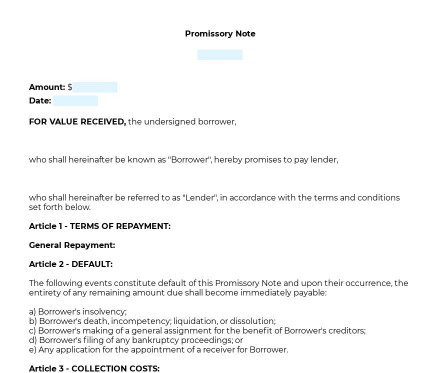Promissory Note Free
When the money borrower (known as the "Borrower") agrees to pay to the lender, this Promissory Note can be used.


 Template Overview
Template Overview
When the money borrower (known as the "Borrower") agrees to pay to the lender, this Promissory Note can be used. This document is also known as the IOU. The Promissory Note differs from a loan agreement as it only binds one party - the Borrower. The borrower undertakes to pay the lender and accepts the possible consequences of not paying the money. However, this contract is one-sided and signed only by the borrower.
Promissory Notes often replace formal loan agreements when borrowing from family or friends. Even small businesses use this document. Meanwhile, banks or big corporations use loan agreements.
You fill out a form. The document is created before your eyes as you respond to the questions.
At the end, you receive it in Word and PDF formats. You can modify it and reuse it.
 How to use this template
How to use this template
When a person or business borrows from another person or business, this document can be used. Note that these types of borrowings are usually made between friends or family. The reason for it is quite simple - this document is one-sided and signed just by one party, the Borrower.
The document states basic facts about the loan, its amount, and when the borrowed money will be repaid. It also describes information about both parties: their names and addresses.
This Promissory Note will also include a determination of the biggest issue with the loan - whether or not the interest will be charged.
This simple document is more for personal use. Use the Loan Agreement (ideti linka) for a comprehensive loan agreement.
 Applicable law
Applicable law
In the US, Article III of the Uniform Commercial Code (the "UCC") governs Promissory Notes.
Ready to build your document from this template?



 Please wait
Please wait